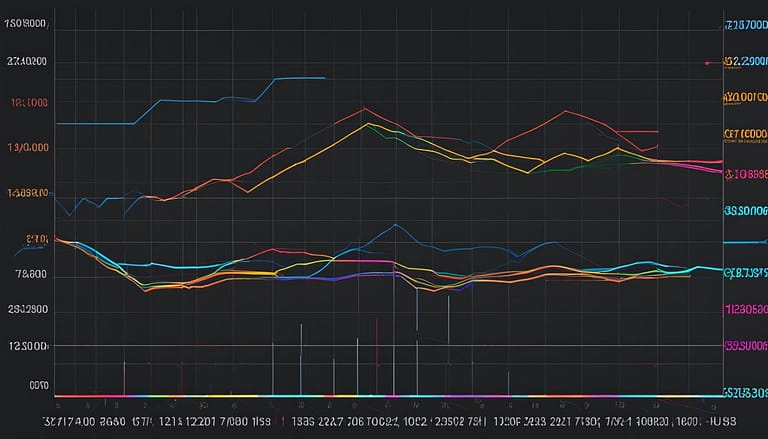A Guide to Cryptocurrency Funds and ETFs
With the advent of digital currency, the financial landscape has witnessed the rise of new investment opportunities, particularly in the form of Cryptocurrency Funds and ETFs (Exchange-Traded Funds). These innovative financial vehicles equip investors with the means to partake in the burgeoning digital asset market, sans the need to assume the complexities of direct ownership. In the ever-dynamic world of finance, these instruments have carved out a niche, offering a semblance of familiarity through their alignment with traditional investment structures while still tapping into the high-growth potential of cryptocurrencies.
The maturation of these funds is evident in the robustness of options available, ranging from single-asset funds focusing on one particular cryptocurrency, to diversified portfolios that mitigate risk by spreading investments across an array of digital assets. In this landscape, the remarkable development within the Canadian financial market has been the integration of crypto-related investment instruments into well-regulated and accessible forms, such as ETFs. This eliminates several barriers to entry for casual investors and seasoned financiers alike, making it increasingly straightforward to incorporate crypto into a well-rounded investment portfolio.
Key Takeaways
- ETFs provide a guided entry point into the world of cryptocurrency, ideal for those seeking exposure without engaging in complex transactions.
- As the first of its kind, the ProShares Bitcoin Strategy ETF heralds a new era of crypto-infused financial products on the stock market.
- The introduction of cryptocurrency spot ETFs reflects a significant regulatory shift and the mainstream financial market’s acceptance.
- Cryptocurrency funds offer diversification in investment strategies, particularly suitable for portfolios seeking modern asset distribution.
- Investing in crypto ETFs and funds can mitigate certain risks associated with direct digital asset ownership, such as security concerns and transaction fees.
Understanding Cryptocurrency Funds and Their Growth
The landscape of Cryptocurrency Funds is evolving rapidly, aided by significant Growth in the variety and complexity of funds available to investors. These funds, which allow for the simplified entry into Digital Assets, have seen substantial innovation, especially with the advent of crypto index funds. Regulatory Developments further influence this progression, introducing new possibilities and frameworks for these financial offerings.
Key players like BITW and CRYPTO20 have been instrumental in laying the groundwork for accessible cryptocurrency investment. BITW tracks an array of major digital assets, while CRYPTO20 stands out as the world’s first tokenized crypto market index fund, signalling a shift in how investors can engage with the market.
| Cryptocurrency Fund | Focus | Impact on Market |
|---|---|---|
| BITW | Top 10 Crypto Assets | Represents ~80% Market Cap |
| CRYPTO20 (C20) | Tokenized Index Fund | First of its kind, paving the way for others |
| Various Hedge Funds | Higher Risk/Return Profile | Appeal to a niche audience of investors |
The expansion of these funds is not solely due to market demand but a result of increased Regulatory Developments. Over 3,500 crypto-related fund applications were recorded in a single year, indicating a maturing market and sophisticated infrastructure. These developments have allowed investors greater flexibility in asset diversification and a more straightforward path into the digital asset market.
Moreover, newer investment structures offer competitive advantages such as lower fees and rebalancing mechanisms, crucial during turbulent market conditions. The sophistication and potential of cryptocurrency funds as mainstream financial vehicles are evidenced by their methodical adaptations to market needs and regulatory guidelines.
Exploring the Role of Crypto ETFs in Investment Portfolios
As financial markets evolve with the rise of digital currencies, Crypto ETFs stand at the forefront, merging the revolutionary appeal of cryptocurrencies with the tried-and-true frameworks of traditional investing. Investors across Canada and globally are turning to these versatile instruments to balance their investment portfolios with innovation and familiarity. Let’s delve into how Crypto ETFs are harmonizing with conventional financial systems and their unique benefits over direct cryptocurrency ownership.
How Crypto ETFs Integrate with Traditional Stock Exchanges
The seamless Traditional Stock Exchange Integration of Crypto ETFs makes them a cornerstone for contemporary investors. Without the need for specialized exchanges or wallets, they offer a straightforward pathway to cryptocurrency ownership through familiar brokerage accounts. This integration provides Canadians with an unprecedented opportunity to diversify portfolios while remaining grounded in a regulated investment climate.
Advantages of ETFs Over Traditional Cryptocurrency Ownership
The Advantages of ETFs extend beyond their investment market familiarity. These funds encapsulate the potential of digital assets, minus the hassles of direct management. Here’s a concise expansion on the primary benefits:
- Cost-Effectiveness: Investors avoid the high fees associated with maintaining crypto wallets or trading on digital currency exchanges.
- Security: The responsibility for securing digital assets lies with the ETF provider, circumventing the risks individual investors face with cyber threats.
- Accessibility: With Crypto ETFs, entering the digital asset market becomes more accessible for novices and seasoned investors alike.
- Regulatory Oversight: Trading on regulated exchanges ensures transparency and investor protection.
| Crypto ETF Feature | Direct Cryptocurrency Ownership | Impact on Investor Experience |
|---|---|---|
| Brokerage Account Access | Crypto Exchange Account Needed | Simplified vs. Complex Access |
| Regulated Investment | Minimal Oversight | Enhanced Security vs. Potential Risk |
| Professional Asset Management | Self-Managed Assets | Less Responsibility vs. Full Control |
| Fees and Costs | Variable Costs and Network Fees | Predictable Expenses vs. Unforeseen Charges |
The uptick in Exposure Without Ownership of the cryptocurrencies themselves showcases the palpable shift towards instruments like Crypto ETFs. Investors are granted the growth potential inherent in these digital assets without the necessity to directly engage with the underlying complexities.
The Emergence of Cryptocurrency Funds in Investment Strategies
The financial world has seen a transformative shift with the introduction of Cryptocurrency Funds into mainstream Investment Strategies. An ever-evolving landscape, the realm of digital assets now includes innovative investment vehicles that have unquestionably influenced the direction and methodologies of investors. Such funds are pivotal in heralding new Emerging Trends within the broader investment sphere, redefining what it means to diversify one’s portfolio in today’s digital age.
Take, for example, crypto venture capital funds that are pivotal in funding nascent blockchain enterprises. Renowned firms such as Polychain Capital and Andreessen Horowitz are at the forefront, actively investing in startups and shaping the industry’s future. What sets these cryptocurrency funds apart is their inherent scope for diversification, providing investors with an entry point to the digital asset market that was previously unfathomable.
| Investment Fund | Focus Area | Notable Investments | Impact on Digital Economy |
|---|---|---|---|
| Polychain Capital | Early-stage Blockchain Startups | Polkadot, Orchid | Pioneering Growth of Decentralized Protocols |
| Andreessen Horowitz | Emerging Crypto Networks and Companies | MakerDAO, Libra | Nurturing Innovation and Broadening Crypto Adoption |
Understanding this burgeoning market requires a deep dive into the investment strategies employed by cryptocurrency funds. Many seek opportunities in Emerging Trends such as decentralized finance (DeFi) and NFT markets, betting on the growth potential of these sub-sectors. It’s not merely about investment but also fostering collaboration, development, and innovation within the cryptosphere.
“Cryptocurrency Funds represent not just financial investment but also a philosophical investment in the potential of blockchain technology and a commitment to fostering its growth.”
- Crypto Hedge Funds focusing on short and long-term positions.
- Index-style Funds tracking top-performing cryptocurrencies.
- Private Equity Crypto Funds invested in blockchain infrastructure.
Cryptocurrency Funds have indeed broken new ground, blending traditional Investment Strategies with the dynamics of present-day tech markets. This innovative merger suggests an exciting future for investors and enterprises alike, eager to explore and expand within the thriving landscape of digital assets.
The Mechanics of a Cryptocurrency ETF
Delving into the mechanics behind a cryptocurrency ETF, investors encounter various modalities through which these funds aim to track and replicate the movements of the digital asset markets. Understanding the nuances between the different structures is pivotal for aligning the investing process with the market’s performance and individual investment goals.
Spot vs. Futures Based Cryptocurrency ETFs
Spot ETFs and Futures ETFs represent two distinct approaches within the spectrum of cryptocurrency ETF mechanics. Spot ETFs deliver direct exposure to cryptocurrencies, purchasing the actual digital tokens to reflect the ongoing spot prices within the markets. This type of ETF investment appeals to those who seek a performance that mirrors the real-time shifts in cryptocurrency value.
However, where holding actual cryptos isn’t the strategy of choice, Futures ETFs come into play. Futures-based ETFs do not hold cryptocurrencies directly; instead, they buy futures contracts on digital assets. These contracts forecast the buying or selling price at a predetermined future point, allowing investors to bet on the price direction of the cryptocurrency market.
The Process of Tracking and Investing in Crypto Markets
Successfully tracking crypto markets involves employing a strategic approach that reflects the performance of digital assets or their derivatives. Identifying the right Cryptocurrency ETF Mechanics compatible with one’s financial strategies can significantly impact the efficacy of an ETF Investment. Spot ETFs and Futures ETFs provide varied levels of market correlation and risk exposure, making the understanding of their mechanics crucial for effective portfolio management.
The Investing Process for cryptocurrency markets through ETFs distinguishes itself by offering a balance. It mitigates the complexity typically associated with direct cryptocurrency investments while still capturing the market’s growth potential. In doing so, investors can navigate the volatile waters of digital assets more confidently, entrusting the complex aspects of asset tracking to the fund managers who oversee these ETF investments.
Crypto ETF Options: Diversification and Selection
Investors navigating the fast-paced domain of cryptocurrencies are increasingly gravitating towards Crypto ETF Options as a means of achieving Diversification and precise Asset Selection within their portfolios. The diversity available through crypto ETFs extends from those honing in on individual assets to those encapsulating a range of digital currencies, offering a broad spectrum of strategies for both seasoned and novice investors alike.
Single-asset crypto ETFs specialize in one cryptocurrency, targeting investment to a specific digital asset. In contrast, multi-asset crypto ETFs spread investments across a variety of cryptocurrencies, which can provide a safety net against the volatility of a stand-alone crypto investment. To intensify the focus even further, industry-sector ETFs scan the horizon for opportunities within the crypto-related business ecosystem, giving investors access to companies leading the tech wave.
“Crypto ETFs bestow the dual benefits of diversification and asset selection, making them an indispensable tool in the modern investor’s arsenal. They adapt traditional investment approaches to a digital age, balancing risk while capitalizing on the potential for substantial returns.”
The pie chart in the center aligns perfectly with our topic, illustrating how diversification within crypto ETF sectors can optimize an investment portfolio’s structure. To aid in this sophisticated asset selection, here’s a comparative list of ETF options:
| Type of Crypto ETF | Target Exposure | Investor Benefit |
|---|---|---|
| Single-Asset Crypto ETFs | One specific cryptocurrency | High exposure to the performance of a single asset |
| Multi-Asset Crypto ETFs | Multiple cryptocurrencies | Diversification across various digital currencies |
| Industry-Centric Crypto ETFs | Companies in the crypto sector | Investment in the growth of crypto-related companies |
To truly wield the power of Crypto ETF Options, investors must match their ETF choice with their financial horizons and risk tolerance. With foresight and strategic planning, diversifying across different crypto assets can lead to a robust, resilient, and potentially lucrative investment landscape.
Cryptocurrency Funds: Accessing the Digital Asset Market
The evolution of finance has ushered in Cryptocurrency Funds, providing a secure and sophisticated approach to Digital Asset Market Access. As direct cryptocurrency investment poses its set of challenges, cryptocurrency funds have risen as a compelling alternative, offering both retail and institutional investors a method to partake in the thriving digital economy. These funds serve as vehicles to invest in diversified portfolios of digital assets, which are meticulously managed by financial professionals. The allure for investors is the combination of convenience and enhanced security that these funds offer.
One of the fundamental advantages of investing in Cryptocurrency Funds is the Secure Investment proposition they put forward. Given the volatile nature of the digital market, the added layer of security ensures that investor capital is subject to strict regulatory measures traditionally absent in the broader crypto space. The management of these funds has a fiduciary responsibility to adhere to high standards of investment practices, providing a much-welcomed layer of investor protection within the often tumultuous digital asset realm.
Investing in Cryptocurrency Funds means entrusting market professionals to navigate the complexity of the digital asset market, ensuring that your capital is not only secure but also poised to capture growth led by industry expertise.
Moreover, Cryptocurrency Funds mitigate the intricacies of direct crypto transactions, which can be daunting for many investors. From creating wallets to managing private keys and understanding blockchain technology, the operational barriers to entry are reduced, enabling a broader scope of investors to gain exposure to cryptocurrencies without needing a technical background of the domain.
- Access to a variety of digital assets within a single investment
- Dedicated fund managers providing active portfolio oversight
- Regulatory compliance offering investor peace of mind
- Reduced risk of direct asset handling and associated cyber threats
As the landscape for digital assets continues to mature, Cryptocurrency Funds signify an increasingly important pathway for secure and regulated market participation. They not only simplify the investment process but also leverage industry knowledge to strategize asset allocation, with an aim to maximize returns for investors seeking to capitalize on the growth of the digital economy.
Risk Analysis of Crypto Funds and ETFs
Investing in crypto funds and ETFs unavoidably involves navigating the treacherous waters of Market Volatility and understanding the Regulatory Impact on these investment vehicles. A detailed assessment is imperative for investors looking to minimize risks while capitalizing on the growth potential of digital currencies.
Evaluating Market Volatility and Regulatory Impact
The landscape of cryptocurrency investments is often turbulent, with frequent and unpredictable price changes. Risk Analysis in this context demands a keen eye on Market Volatility, which can significantly affect the performance of crypto funds and ETFs. On the flip side, the evolving Regulatory Impact, particularly stringent oversight by financial authorities, can offer a cushion against the wild swings of the crypto market.
Comparative Analysis of Fees and Expense Ratios in ETFs
ETF Fees and Expense Ratios form a crucial part of the investment equation. A Comparative Analysis reveals that effectively managed crypto ETFs usually incur higher costs than traditional ETFs, reflecting the intricacy involved in managing and safeguarding digital assets.
| Crypto ETF | Traditional ETF | Difference |
|---|---|---|
| Expense Ratio | 0.55% | 0.21% |
| Management Fees | 0.30% | 0.10% |
| Operational Expenses | 0.10% | 0.07% |
While these numbers represent a snapshot, they underscore the importance of diligent scrutiny in the decision-making process for investors engaged in crypto-based securities.
Spotlight on Significant Crypto Fund and ETF Players
The landscape of cryptocurrency investment is continually being shaped by influential players, with a distinct focus on crypto funds and ETFs that bring niche expertise and substantial market presence. In this context, the analysis of investment strategies and the performance of leading entities is essential for understanding the shifting dynamics of the digital asset market.
Insights into Major Crypto Funds and Their Strategies
Renowned crypto funds such as Polychain Capital, Digital Currency Group, and Pantera Capital have carved out major roles in directing the momentum of cryptocurrency investments. These funds are lauded for their significant assets under management and for pioneering innovative investment strategies tailored to the evolving digital landscape.
- Polychain Capital is known for its discerning investment in groundbreaking blockchain technologies and protocols, focusing on long-term value creation.
- Digital Currency Group boasts a diversified portfolio that includes cryptocurrency mining, blockchain startups, and established digital asset exchanges.
- Pantera Capital offers a dual approach, melding venture capital with hedge fund techniques to optimize its cryptocurrency market strategies.
In-Depth Look at Leading Crypto ETFs and Their Performance
When evaluating market offerings, leading Crypto ETFs such as the ProShares Bitcoin Strategy ETF and the VanEck Bitcoin Strategy ETF are under the spotlight. Their performance, hinging on the volatile crypto market, demands continuous analysis.
| ETF Name | Assets Under Management | Underlying Asset | 1-Year Performance | Expense Ratio |
|---|---|---|---|---|
| ProShares Bitcoin Strategy ETF | $1.2B | Bitcoin Futures | 25% | 0.95% |
| VanEck Bitcoin Strategy ETF | $500M | Bitcoin Futures | 23% | 0.65% |
The scrutiny of their investment approach reveals the intricacies of managing portfolios based on crypto futures, highlighting the potential for tracking errors and the influence of contract rollovers on their net asset values. Market presence and investor trust go hand-in-hand with a clear and transparent approach to managing these novel financial instruments.
Regulatory Environment and Its Effect on Crypto ETFs
The regulatory environment is a crucial factor in the development and acceptance of Crypto ETFs. Regulatory bodies play a pivotal role in the establishment of compliance standards, influencing the stability and growth of cryptocurrency exchange-traded funds. Recent developments indicate a significant shift towards integrating digital assets within regulated financial markets.
With crypto funds looking for legitimacy in the eyes of the mainstream finance community, compliance with regulatory guidelines is not just a legal requirement but also an essential aspect of building investor trust. The Securities and Exchange Commission’s (SEC) approval of cryptocurrency spot ETFs, for example, signals a maturing landscape where traditional and digital asset realms converge, enhancing the potential for future growth of the sector.
Below is a table comparing different regions and their advances in the crypto ETF regulatory spectrum, demonstrating how various jurisdictions are approaching the incorporation of digital assets into their financial systems:
| Region | Status of Crypto ETF Approval | Key Regulatory Body |
|---|---|---|
| United States | Approved cryptocurrency spot ETFs | SEC (Securities and Exchange Commission) |
| Canada | First North American country to launch a Bitcoin ETF | OSC (Ontario Securities Commission) |
| European Union | Various Crypto ETFs available, subject to member state regulations | ESMA (European Securities and Markets Authority) |
As regulators continue to sculpt the cryptocurrency regulatory framework, investors will likely witness heightened compliance and transparency in the operations of Crypto ETFs. Embracing this shift, investment firms are steadily aligning with the compliance standards set forth while innovating their products to meet both investor demand and regulatory requirements.
Investor Guide: How to Choose the Right Crypto Fund or ETF
Embarking on the journey of investing in crypto funds or ETFs demands a strategic assessment of your financial landscape. The dynamic nature of the cryptocurrency market necessitates a methodology rooted in a clear understanding of your investment goals and how each fund aligns with your financial aspirations. The pathway to choosing the right crypto fund or ETF intertwines various critical elements including liquidity, transparency, and asset allocation, which shape the investment experience and potential outcomes.
Assessing Your Investment Goals with Crypto Options
The landscape of crypto investment is diverse, offering opportunities that range from conservative to highly speculative ventures. Identifying your investment goals is akin to setting the coordinates for your journey; it determines the direction and pace of your investment decisions. Whether you seek growth, stability, or a combination, crypto funds and ETFs provide a spectrum of options tailored to various risk profiles and investment horizons. Recognizing the compatibility of your goals with the volatility and growth potential of crypto assets is integral to your selection process.
Understanding Liquidity, Transparency, and Asset Allocation
Two pivotal factors in the realm of crypto fund investment are liquidity and transparency. Liquidity reflects the ease with which assets can be bought or sold at stable prices, a crucial consideration for any investor who may need to quickly alter their positions. Transparency, on the other hand, reassures investors through clear, regular disclosures about fund operations, holdings, and performance metrics—key to building trust and facilitating informed investment decisions.
Asset allocation is the cornerstone of investment strategy in crypto funds, as it dictates the blend of various digital assets within a portfolio. A well-structured asset allocation in crypto funds helps investors cater to their unique risk tolerance and market outlook, allowing for a balanced approach to cryptocurrency investment. It is important for investors to analyze how their chosen funds bifurcate assets and manage portfolio diversity to align with market changes.
To better illustrate the fundamental aspects investors should consider when evaluating crypto funds and ETFs, consider the following table:
| Aspect | Relevance to Investor Goals | Impact on Investment Strategy |
|---|---|---|
| Liquidity | Essential for flexibility and risk management in rapidly changing markets. | High liquidity enables easier entry and exit from positions, adding a layer of security. |
| Transparency | Builds investor confidence through clarity on fund operations and asset holdings. | Transparent reporting aids in evaluating fund performance and adherence to strategy. |
| Asset Allocation | Defines risk exposure and potential returns in alignment with investor preferences. | Strategic asset distribution navigates market volatility and targets optimal returns. |
Future Trends: The Evolving Landscape of Cryptocurrency Investment
As the cryptocurrency investment landscape stands on the cusp of transformation, the industry is earmarked for significant progression, with both regulatory evolution and technological innovation paving the way. The expanding arena of cryptocurrency funds and the introduction of varied ETFs reflect a sophisticated amalgamation of traditional investment principles with advanced digital asset management strategies.
Anticipated Developments in Crypto ETFs and Regulations
The Cryptocurrency Investment Landscape is primed for Anticipated Developments that promise to shape the future of Cryptocurrency Funds. Market watchers foresee regulatory updates that could favor the inception of novel ETFs, providing investors with diversified options. Firms such as BlackRock are already positing themselves for significant forays into this market, indicating a maturing confidence in cryptocurrency as a staple in comprehensive investment portfolios.
Technological Advancements Impacting Cryptocurrency Funds
Stepping into the future, Emerging Technologies are set to revolutionize Cryptocurrency Funds through state-of-the-art blockchain solutions and enhanced security protocols. As these funds evolve, we anticipate witnessing a seamless blend of accessibility, transparency, and efficiency, contributing to a thriving environment for seasoned investors and newcomers alike. These Technological Advancements will not only bolster fund mechanics but significantly augment the overall integrity of digital asset investment.
Conclusion
In the panorama of contemporary investment opportunities, cryptocurrency funds and ETFs stand out as progressive financial constructs, marrying the robust traditions of investment management with the dynamic realm of digital assets. As these investment vehicles edge further into the mainstream, their integration into the portfolios of both institutional and retail investors is set to accelerate—thanks in part to continuous evolution in regulatory frameworks and financial technology innovations.
The synthesis offered by cryptocurrency investment vehicles captures the zeitgeist of modern finances, presenting a diversified array of options with varying degrees of exposure to the crypto markets. For those keen on this niche, astute navigation amongst these offerings is paramount. Decisions must be informed by a solid comprehension of each vehicle’s nuances, the nuances of market volatility, and the implications of regulation on these digital instruments; only then can investors truly reap the benefits of this asset class’s potential.
As we wrap up this Cryptocurrency Investment Synopsis, it’s evident that the anticipation swirling around cryptocurrency funds and ETFs is justified. With the promise of melding traditional solidity with innovative growth, these investment channels stand ready to redefine wealth portfolios. The challenge for investors lies in marrying diligent risk management with strategic asset allocation, ensuring that participation in this nascent market is both prudent and promising.










